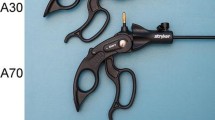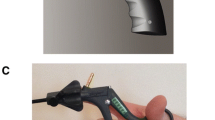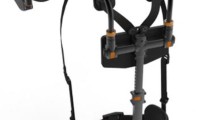Abstract
Background
It is very important for surgeons who perform minimally invasive surgery (MIS) to maintain proper postural stability, which kinematic research can determine. Previous studies in surgical ergonomics have shown that postural stability is correlated to instrument type, task difficulty, and skill level. What should also be considered is that surgeons may strategically change stance or joint movement to achieve better surgical outcomes while potentially subjecting themselves to greater risk. Background information about subjects, e.g., joint impairment, should be considered an important surgical ergonomic element. Such information can lead to more realistic and accurate conclusions about postural stability and joint kinematics.
Methods
A highly experienced and skilled right-handed surgeon developing carpal tunnel syndrome in both wrists was recruited into a small (6 subjects) performance study of pegboard transfer and circle-cutting tasks from the Fundamentals of Laparoscopic Surgery (FLS) skill set. Joint kinematics and postural data were collected using two associated force plates and a motion capture system of 12 digital, high-resolution, high-speed, infrared cameras.
Results
Each task was completed in less than 90 s. In pegboard transfer, the subject increased shoulder abduction angle to align his hand and forearm and minimize wrist flexion. When circle-cutting required excessive wrist flexion, the subject maintained his lower body position and stance while twisting his torso, a strategy that appeared to stabilize tangential direction related to cutting while maintaining a fixed orientation of forearm, wrist, and hand. In another circle-cutting trial, the subject changed his stance primarily by shifting foot position as necessary to obtain better scissor approach angles. These compensatory, strategic movements caused an increase in overall postural sway but did not represent postural instability.
Conclusion
This case study indicated that poor joint kinematics or postural stability does not necessarily correlate to poor performance. Instead, they may indicate positive compensatory or strategic movements.

Similar content being viewed by others
References
Emam TA, Hanna G, Cuschieri A (2002) Comparison of orthodox vs off-optical axis endoscopic manipulations. Surg Endosc 16: 401–405
Gillette J, Quick N, Adrales G, Shapiro R, Park AE (2003) Changes in postural mechanics associated with different types of minimally invasive training devices. Surg Endosc 17: 259–263
Halliday SE, Winter DA, Frank JS, Patla AE, Prince F (1998) The initiation of gait in young, elderly, and Parkinson’s Disease subjects. Gait Posture 8: 8–14
Karst GM, Venema DM, Roehr TG, Tyler AE (2005) Center of pressure measures during standing tasks in minimally impaired persons with multiple sclerosis. J Neurol Phys Ther 29(4): 170–180
Lee G, Kavic SM, George IM, Park AE (2006) Correlation between postural stability and performance time during fundamentals of laparoscopic surgery (FLS) tasks (poster). Annual conference of the association of surgeons of Great Britain and Ireland (ASGBI), Edinburgh, Scotland. Br J Surg 93(Suppl s1): 206
Lutz GE, Palmitier RA, An KN, Chao EYS (1993) Comparison of tibiofemoral joint force during open-kinetic chain and closed-kinetic chain exercises. J Bone Joint Surg Am 75(5): 732–739
Masani K, Popovic MR, Nakazawa K, Kouzaki M, Nozaki D (2003) Importance of body sway velocity information in controlling ankle extensor activities during quiet stance. J Neurophysiol 90: 3774–3782
Murray MP, Seireg A, Scholz RC (1967) Center of gravity, center of pressure, and supportive forces during human activities. J Appl Physiol 23: 831–838
Nault ML, Allard P, Hinse S, Le Blanc R, Caron O, Labelle H, Sadeghi H (2002) Relations between standing stability and body posture parameters in adolescent idiopathic scoliosis. Spine 27(17): 1911–1917
Panzer VP, Bandinelli S, Hallet M (1995) Biomechanical assessment of quiet standing and changes associated with aging. Arch Phys Med Rehabil 76: 151–157
Parkin M, Isabel L (1995) Ergonomics, engineering, and surgery of endosurgical dissection. J R Coll Surg Edinb 40: 120–132
Reyes DAG, Tang B, Cuschieri A (2006) Minimal access surgery (MAS)-related surgeon morbidity syndromes. Surg Endosc 20: 1–13
Rietdyk S, Patla AE, Winter DA, Ishac MG, Little CE (1999) Balance recovery from medio-lateral perturbations of the upper body during standing. J Biomech 32: 1149–1158
Smith SGT, Torkington J, Brown TJ, Taffinder NJ, Darzi A (2002) Motion analysis. Surg Endosc 16: 640–645
Zheng B, Verjee F, Lomax A, MaxKenzie CL (2005) Video analysis of endoscopic cutting task performed by one vs two operators. Surg Endosc 19: 1388–1395
Acknowledgments
This study was supported by a grant from the U.S. Army Medical Research and Materiel Command (USAMRMC), and equipment was provided in part by U.S. Surgical Corp. (Norwalk, CT). The authors acknowledge the thoughtful assistance of Rosemary Klein in the editing of the manuscript.
Author information
Authors and Affiliations
Corresponding author
Rights and permissions
About this article
Cite this article
Lee, G., Kavic, S.M., George, I.M. et al. Postural instability does not necessarily correlate to poor performance: case in point. Surg Endosc 21, 471–474 (2007). https://doi.org/10.1007/s00464-006-9144-1
Received:
Accepted:
Published:
Issue Date:
DOI: https://doi.org/10.1007/s00464-006-9144-1




